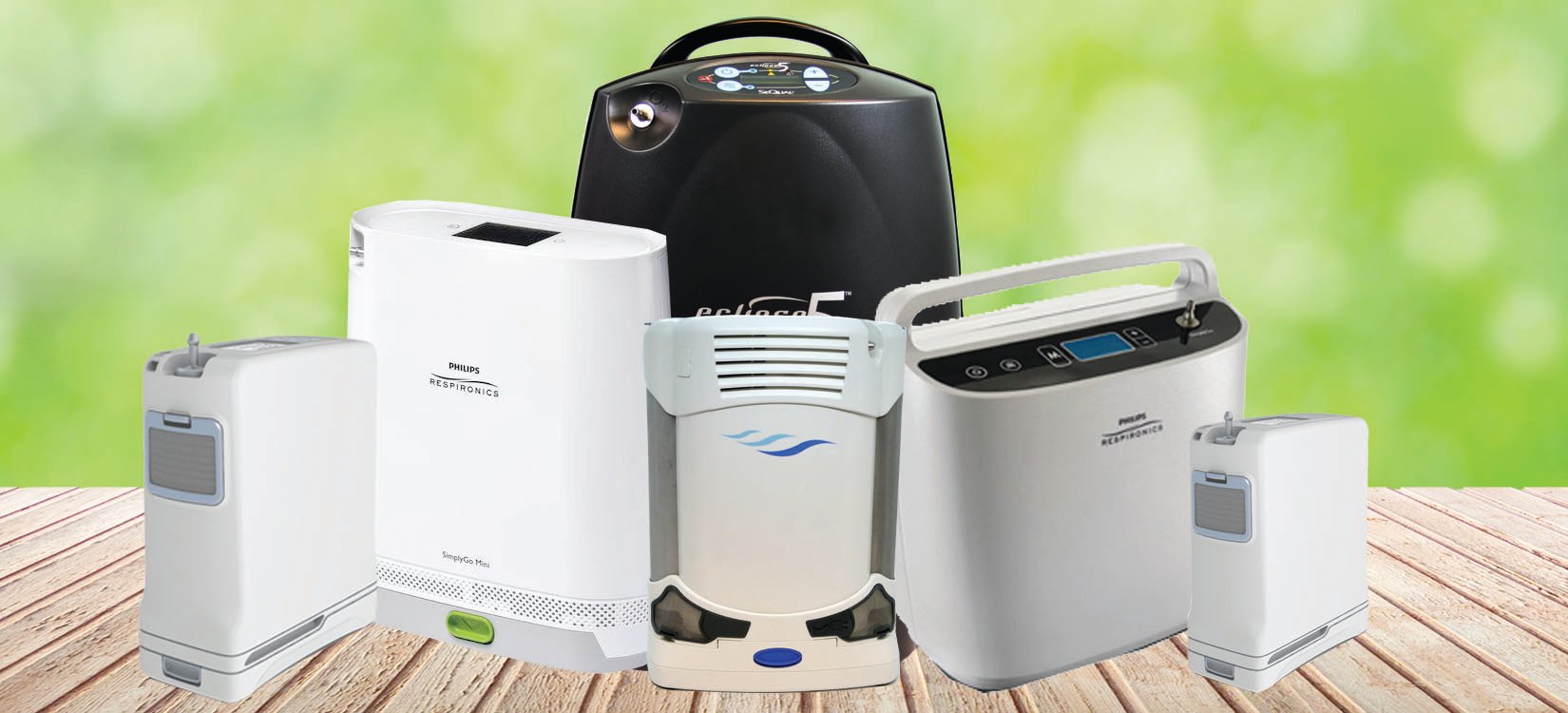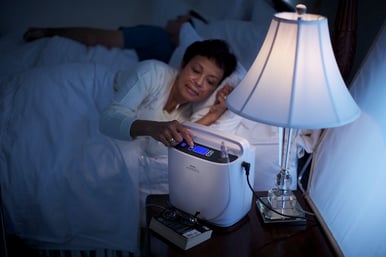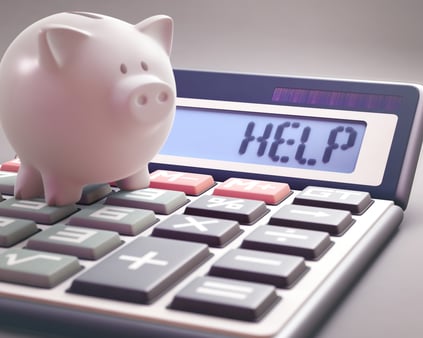
O2 and Your Body
Oxygen is carried by a protein called hemoglobin contained within your red blood cells to every cell and organ in your body.. The amount of oxygen being carried in your blood is known as oxygen saturation.
If you’ve been instructed to monitor your saturation levels on your own you’ll likely use a pulse oximeter. They are painless, easy to use, and inexpensive. There are even some apps made for your phone that can measure oxygen saturation.
If your doctor suspects that you might have a lung condition, you may have been given an arterial blood gas test. This test is more invasive, but also more accurate. With these results your doctor will have a clearer picture of your lung condition and will be able to more accurately prescribe supplemental oxygen flow.
Most people with normal lung function have saturation levels in the high 90 percentile. Anything above 90% is considered acceptable. However if you have saturation levels of 88% or lower, your doctor will generally prescribe supplemental oxygen.
If your oxygen saturation levels are continually low over a long period of time, irreparable damage can occur. When you were low on oxygen you were probably experiencing headaches, confusion, dizziness, shortness of breath, or chest pain.
If oxygen levels are low over an extended period of time it can cause neurological damage, organ failure, or even death. So if your doctor has prescribed supplemental oxygen, don’t delay its use.
To read about the top 7 Indicators that You May Need Supplemental Oxygen, click here.
Your Prescription
Your doctor will prescribe you a flow rate based upon what they believe will keep your oxygen saturation number above 90%. There are two types of concentrators; Continuous or Pulse Flow
Continuous or pulse flow could also be called, continuous or on demand flow. Continuous flow concentrators push oxygen constantly while pulse flow doses are triggered by your inhalation.
As of right now the highest flow available for portable concentrators is 9 pulse or 3 continuous.
Keep in mind that if you use a CPAP or BiPAP to sleep at night, you will need a continuous flow concentrator.
Use as directed
Oxygen is just like any other prescription medication. Do not discontinue use or change your dose without speaking with your doctor or respiratory therapist first. Follow your doctor’s instructions. It is a myth that you will become dependent or addicted to oxygen the more you use it. On the contrary, everyone is already dependent on oxygen. Not using it can cause organ and tissue damage, or even death. Turning up oxygen higher than you have been instructed can cause other issues or mask existing problems. It’s very dangerous.
Nighttime Use

If your doctor has instructed you to use oxygen at night you will need a concentrator with what is known as intelligent delivery or sleep mode. Most pulse flow units come with this feature. Intelligent delivery means that the machine self-adjusts as your breathing slows or becomes more shallow as you drop off to sleep.
If you have a Cpap or BiPAP you will need to get a continuous flow machine as they do not operate with pulse flow concentrators.
Weight
Concentrators are getting smaller all the time. The smallest concentrator is the Inogen one G4 which weighs in at just 2.8 pounds.
If you need continuous flow you might need a bigger concentrator but keep in mind that pushing or pulling a larger machine actually expends less energy than carrying a small concentrator over time. Consider your groceries. You can push a lot of them around for an extended time but carrying them from the car to the house generally uses a lot more energy.
Battery Life
Battery life is estimated by the manufacturer. It is based upon 20 breaths per minute on a setting of 2. If you breathe faster, your battery life will go down. If you need a higher setting your battery life might go down and manufacturer's battery life rating is just an estimate.
Many concentrators have two battery options. The smaller battery will usually give half the battery life of the larger one but is up to a pound lighter. You can get the smaller one for running quick errands so you can carry around less weight and then get a larger battery for travel or longer outings.
Filling Your Oxygen Prescription
If you have been prescribed oxygen you’ll likely want to begin shopping for a portable oxygen concentrator. They are far more convenient than cumbersome oxygen tanks and will allow you to continue to travel and in general, live a fuller, more independent life.
If you have newly been prescribed oxygen, this is your best chance at getting either Medicare or your insurance company to furnish you with a concentrator. Once you have been using tanks it can be difficult to get them to switch you over to a concentrator. If Medicare covers your concentrator you will not own the concentrator but will be given one to use. Be sure to ask what your maintenance responsibilities, if any, will be.
Unfortunately, oftentimes a portable oxygen concentrator is an out of pocket expense. There are several things to keep in mind. They are sizable investments and while it’s important to get the best value, you’ll also want to make sure that you’re getting a machine that is going to be able to benefit you right away, but also be suitable for any progressing oxygen needs you may experience.
Warranties and Service
You’ll also want to understand what process you’ll have to go through if your machine needs service in the future. Be sure to ask what the process is for sending a machine for service. Ideally you should be sending it back to the place you bought it from and not having to deal with the manufacturer which can entail a lot more red tape.
1st Class Medical has its own service department which cuts down on return time dramatically. You’ll also get lifetime phone access to tech support in case you have any questions. Our techs can walk you through how to fix most problems over the phone. If your machine does need to get sent in, they’ll help you arrange shipping.
The most common maintenance process is changing the sieve beds which need to be changed every year or so. Most manufacturers do not cover sieve beds under their warranty, so be sure to ask. It’s also important to know that some concentrators require the unit to be sent in to get sieve beds changed while some you can do on your own.
Saving Money

Purchasing a portable oxygen concentrator is an important investment in your continued health but it is a sizable one. We understand the desire to save a little cash on the purchase but safety and medical accuracy should be your number one concern. Having said that, there are some safe ways to make the purchase a little easier on your budget.
One way you could save some money is to look into a used or refurbished concentrator. This can be risky but if you follow these guidelines and buy from a reputable dealer you can save money while being safe as well.
Difference Between Used and Refurbished
The terms used and refurbished are sometimes used interchangeably but they actually mean very different things.
Used- A used concentrator is a machine that has likely been taken in trade or returned by a customer. The machine has been sanitized and oxygen purity levels have been tested. Any parts that need servicing have been fixed or replaced.
Refurbished- A refurbished concentrator basically has all new mechanical parts while the casing and some of the other cosmetic parts are being repurposed.
If you are buying a used or refurbished machine be sure that you understand what the warranty covers. Manufacturer warranties often don’t cover used machines. Be sure to ask and get the warranty details in writing.
Be sure to purchase used and refurbished concentrators from an authorized dealer instead of Craigslist, or Ebay or similar online platforms.
Stick to purchasing from reputable dealers. There are several risks involved with purchasing a machine online or via Craigslist from a private party.
- No safety or mechanical inspection. Private parties have no way of verifying that the concentrator is delivering medical grade oxygen. This puts your health at risk. Low oxygen saturation, as you know can have serious, or even deadly, physical consequences.
- Machine may not be sanitized. Unsanitized machines can put you at risk for viruses, bacterial illnesses, and even serious infections such as Staph or MRSA.
- No guarantee. If the concentrator is not delivering acceptable oxygen levels you often have no recourse for getting your money back or getting the machine serviced or fixed.
- No warranty. Manufacturers often don’t continue to cover machines that have been traded between private parties. You’re on your own if you need service or repairs.
- You don’t know if the machine has been exposed to smoke. Smoke is extremely harmful to sieve beds and other concentrator components. From a private party, there is no way to tell if the concentrator has been contaminated by cigarette smoke.
- Extreme temperatures effect machines. If the machine was no longer needed there is a chance that it was stored in a garage or other non-climate controlled environment. It could also have been stored somewhere excessively humid. Extreme heat, cold, and humidity are all detrimental to sieve beds and other electronic components.
- You need to speak to an oxygen specialist to ensure you’re getting a machine that best fits your medical needs. There is more to finding the proper fit for a concentrator than just knowing your flow rate. You need to find a machine that will meet your medical needs as well as satisfy your lifestyle expectations. Battery life, weight, portability, and accommodation for other health issues are all vital considerations.
Don’t buy a Foreign Made Concentrator

There are inexpensive concentrators available on Ebay, Amazon, or Craigslist. These are often Chinese or other foreign made concentrators. Over the past several years we have grown used to purchasing Chinese made goods at a discount. It may be fine for some things but not medical devices.
- Medical devices in the US are held to strict guidelines by the FDA. Chinese or foreign made goods are not required to follow these guidelines.
- No recourse if the machine malfunctions. You have no way to return the machine or send it for repairs.
- Down the road there is no service. If your sieve beds wear out or if you lose a filter, you will likely have no one to call to order replacement parts.
- If the machine is not working properly and not keeping you properly saturated, it can cause more harm than good, putting your health at risk.
What Questions Should You Ask
To make sure you’re dealing with a reputable and trustworthy company there are several tools available to you.
- Check the Better Business Bureau reviews. Pretty much any company is going to have a bad review or two. Misunderstandings and miscommunications are bound to happen. If the company has a good amount of reviews and are on the whole positive, it’s a good sign. The larger the number of reviews likely means the longer the business has been operating.
- Verify their physical location. Even if the company is largely an internet retailer they should have a street address and some sort of brick and mortar location to ensure it’s not a fly-by-night operation operating out of a garage.
- Check reviews on their own site as well as review sites such as Google.
- Concentrators are FDA regulated medical devices. A legitimate company will require a prescription from your doctor and be able to answer your questions and make recommendations. Any company who has not seen a copy of your prescription cannot make proper recommendations and this should be a red flag.
- Have a full understanding of what your warranty covers. Be sure to ask, if you should need service, will you be dealing directly with the manufacturer or the company you purchased the machine from. You also might want to find out if there are loaners available.
- Make sure you understand what the process is down the road if your machine should need servicing. Who do you call? Where do you ship it? What’s the average turn time?
- Find out what assistance they give as far as routine maintenance such as sieve bed replacement. As we talked about, some machines allow you to change the sieve beds yourself but some require that you send the machine in to a certified service center.
- What happens if the machine doesn’t work for you or down the road your medical needs change? For a few people a concentrator may not successfully keep them properly titrated. It’s extremely rare but it does happen so it’s important to find out what a company’s return policy is. Sometimes your lung condition will progress and you may outgrow your current machine. You don’t want to be stuck with an expensive piece of equipment that you can’t use. In addition to learning about the immediate return policy, you’ll want to find out if there is some sort of trade in, buy back program, or other method to get some value from a concentrator that you can no longer use.









